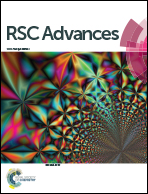Promotional effect of copper(ii) on an activated carbon supported low content bimetallic gold–cesium(i) catalyst in acetylene hydrochlorination
Abstract
The synthesis of a vinyl chloride monomer (VCM) from acetylene hydrochlorination is a highly attractive coal-based route using mercury chloride (HgCl2) as the catalyst. On reducing the use of mercury and with increasing concerns about environmental issues, searching for alternative catalysts has gained interest in recent years. However, to achieve high yield and stability using a mercury-free catalyst in this reaction is a substantial challenge. We approach this question by probing a Cu-added AuCs/AC catalyst working as a highly active, stable and cost-effective catalyst for this reaction. Introducing Cu into the catalyst significantly increased the activity and stability compared to a bicomponent AuCs/AC catalyst, underscoring a remarkable synergistic effect of the three metals. The particularly remarkable enhancement of activity was observed for the catalyst with a Au/Cu/Cs weight ratio of 1 : 1 : 4 (Au = 0.25 wt%), which provided a high turnover frequency of 73.8 min−1 based on Au. Further experiments showed that the AuCuCs/AC catalyst delivered a stable performance during a 600 h test with the conversion of acetylene maintaining more than 98.8% at a C2H2 gas hourly space velocity of 50 h−1 and the estimated lifetime exceeding 6540 h. After a careful characterization of the AuCuCs/AC catalyst and additional catalytic tests, we concluded that the observed enhanced catalytic performance could be associated with the enhanced dispersion of Au particles, the stabilization of Au in the state of Au3+ and facile substrate C2H2 molecule desorption. Compared with the commercial high content HgCl2 catalyst (Hg = 12 wt%), this low content AuCuCs/AC catalyst (Au = 0.25 wt%) has similar activity, higher stability, relative low cost and environmental friendliness, meaning it has potential as an alternative to the HgCl2 catalyst for commercial production of VCM.


 Please wait while we load your content...
Please wait while we load your content...